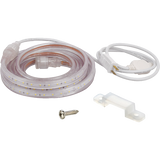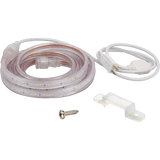How to Provide Proper Light for Aging Eyes
Posted by Dave on for ProLampSales

As we age, our visual acuity naturally deteriorates. This process starts around age 40. After that, normal changes to the aging eye become increasingly noticeable and potentially life changing.
By the time people reach their sixties, seventies, eighties or older, their vision challenges may cause both difficulty in performing basic daily tasks such as reading and eating as well as pose a mobility safety hazard. The human perception of lower light levels may also affect mood and disrupt normal sleep patterns.
As the eye ages, natural changes include:
- Reduced capacity to focus at close range
- Reduced ability to make use of normal light levels because pupil size decreases and less light reaches the retina
- Diminished peripheral vision
- Diminished capacity of the eye to adapt quickly from light to dark
- Reduced contrast and color saturation because the eye's lens becomes less clear
- Reduced ability to see blue color because the lens becomes more yellow
A majority of people experience deterioration of visual acuity because of these factors. In addition, some people also must cope with partial loss of sight from cataracts, glaucoma, macular degeneration and other afflictions of the eye.
Declining visual capabilities can considerably affect the quality of life of older adults. However, well designed lighting systems can help, especially with the natural changes to the eye that inevitably affect most people.
Increase the Light Levels
The easiest way to address some of the challenges caused to the aging eye is simply to increase both the ambient light levels in the spaces occupied by older adults and the proximity of task lighting to the task.
For example, table lamps beside a chair used for reading may not be providing near enough light. Replace the bulbs with ones that provide not only more light but also whiter light. For example, if a table lamp currently uses a 60 watt incandescent, replace it with a 72 watt halogen (equivalent to a 100 watt incandescent). Or, 15 to 20 watt LEDs (100 watt equivalent) could also be used for a more energy efficient option. The result will be increased brightness on the reading material and less frustration for the reader.
Alternately, replace the table lamp with an adjustable task light equipped with a flexible neck that allows the light to be moved closer to the reading material.
While more light improves visual acuity for older adults, care should be taken not to introduce glare which can create additional problems. Make sure light bulbs within the line of sight are shielded with shades or diffusers so they cannot be viewed directly. Also if there are hard, shiny surfaces in the room, adjust the lighting so harsh reflections are avoided.
Establish Similar Light Levels in Adjoining Rooms
Because the aging eye has difficulty adjusting from a brighter to a dimmer condition, try to make the light level in adjoining rooms similar which will allow easier visual transitions. Falls are more likely when older people move between rooms with significantly different brightness levels.
Use Lighting Cues
The visual system helps humans maintain balance. As humans age and the visual system deteriorates, they become susceptible to debilitating falls.
Falls can happen for many reasons, but inadequate lighting is a significant contributor. The Lighting Research Center at Rensselaer Polytechnic Institute has done extensive research on lighting for the aging eye. In one study, they compared different nighttime lighting strategies for visual elements between rooms for residents age 65 and older of an independent living facility. About half of those in the study were labelled at high risk for a fall and half at low risk.
Participants were exposed to different lighting conditions: low light level night lights showing the way to the next room and low light level linear LED strips outlining the doorway and the path to the next room.
The results showed that the linear LED system outlining the path between rooms created strong spatial cues and increased walking stability for both the high and low risk groups. This study suggests that even when it is desirable to have low nighttime light levels, the placement of the lighting is important and can achieve positive results by lowering the risk of a fall. Read the report published by The Lighting Research Center.
LED technology is a particularly attractive light source for the unique requirements of lighting for older adults. Higher light output can be achieved without increasing electric costs. In addition, LEDs with a 3000K color temperature are commonly available and provide brighter appearing, halogen-like white light. Color changing versions of these LED bulbs also allow modulating the wavelengths to increase blue spectrum late in the day (to prevent late afternoon napping) while moving to red spectrum light (allows sleep inducing melatonin levels to rise) toward bedtime.
While the aging of the human eye is inevitable, the challenges can be mitigated by understanding and implementing effective lighting strategies in the living environments of older adults.
Featured Products (View All)
- 0 Comments
- Posted in Health, Household
0 Comments




